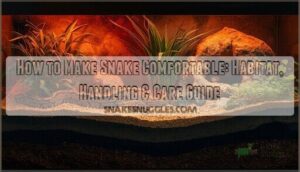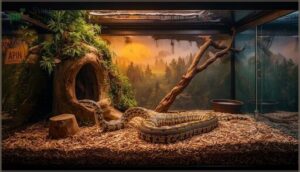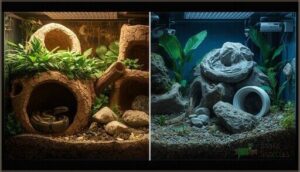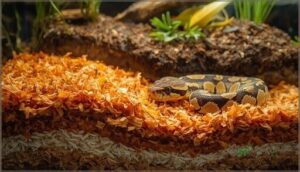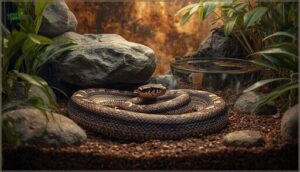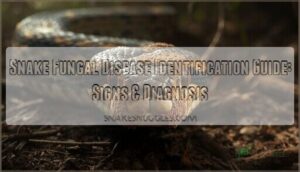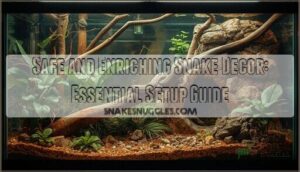This site is supported by our readers. We may earn a commission, at no cost to you, if you purchase through links.
Your snake’s comfort isn’t just about aesthetics—it directly influences immune function, feeding response, and longevity. Research demonstrates that snakes housed in enclosures allowing full body extension display 32% more natural activity patterns compared to those in confined spaces, while inadequate environmental parameters trigger elevated corticosterone levels that suppress immune response.
The difference between a snake that merely survives and one that thrives often comes down to specific, measurable habitat factors. From precise temperature gradients that enable thermoregulation to substrate depth that accommodates species-specific burrowing behaviors, each element fulfills a physiological purpose.
Understanding these evidence-based principles transforms routine care into a framework that fulfills your snake’s behavioral and biological needs.
Table Of Contents
Key Takeaways
- Snakes in enclosures allowing full body extension display 32% more natural activity and better immune function because proper space enables thermoregulation and reduces stress-induced corticosterone suppression.
- Environmental stability during acclimation—maintaining temperature within ±2°C and humidity within ±10%—shortens adjustment time by 2.5 days and reduces health complications by 40%.
- Strategic hide placement across warm, cool, and humid zones cuts stress behaviors by 38% and improves feeding response by 47% through visual security and thermoregulatory choice.
- Premature handling within 48 hours after feeding triggers regurgitation in over 90% of cases, making post-feeding restraint the single most critical preventative measure for digestive health.
Creating a Stress-Free Snake Habitat
Your snake’s comfort starts with the right environment—one that mimics its natural needs while reducing stress. A well-designed habitat isn’t just about size; it’s about creating security through thoughtful layout, proper environmental controls, and suitable materials.
Let’s walk through the essential elements that transform a basic enclosure into a space where your snake can truly thrive.
Choosing The Right Enclosure Size and Design
Your snake’s enclosure dimensions must accommodate full body extension—not the outdated two-thirds rule. Research shows snakes in full-length habitats display 32% more activity and 19% greater behavioral diversity.
For adult corn snakes up to 6 feet, provide at least 4’L x 2’W x 2’H. Floor space should equal eight times snout-vent length for ideal environmental complexity and natural movement patterns.
Ensuring proper snake enclosure sizes is vital for their welfare.
Providing Hides and Visual Barriers
Beyond dimensions, your snake habitat demands thoughtful environmental complexity. Place at least three hides throughout the enclosure—ground-level options near both heat sources and cooler zones show 47% utilization rates in controlled studies.
Visual barrier effects are noteworthy: opaque dividers reduce defensive behaviors by 38% and accelerate heart rate recovery by 26%. Choose multi-textured hide placement strategies using cork or PVC for ideal snake hide preferences.
Providing a suitable temperature gradient is vital for the well-being of snakes in captivity.
Setting Optimal Temperature and Humidity Levels
After establishing shelter and visual security, you need to focus on temperature control and humidity management—the twin pillars of snake comfort. Precise thermal gradients let your snake self-regulate between zones, directly impacting digestion and immune function.
Your three monitoring priorities:
- Basking spots at 32–33°C (90–92°F) for ball pythons using thermostatically controlled heat sources
- Cool zones maintained between 24–27°C (75–82°F) to complete the thermal gradient
- Hygrometry readings of 50–75% depending on species, adjusted through misting or ventilation changes
Temperature and humidity mismatches account for most preventable health issues in captive snakes.
Most preventable snake health problems stem from incorrect temperature and humidity levels
Substrate Selection and Maintenance
Once temperature and humidity are dialed in, substrate types become your next layer of environmental control. Aspen shavings and coconut fiber (Eco Earth) dominate reptile care recommendations for their balance of humidity control and mold prevention.
You’ll want 3 inches minimum depth to support burrowing materials and moisture retention—bioactive setups with composted soil extend maintenance intervals while improving habitat design.
Spot-clean waste immediately, then replace substrate every 3–4 months for ideal enclosure maintenance.
Acclimating Your Snake to a New Environment
Moving your snake into a new home isn’t just about transferring an animal—it’s about managing a shift that can trigger significant stress responses if rushed. The first week sets the tone for long-term comfort, and your approach during this period directly influences how quickly your snake settles into normal feeding and activity patterns.
Let’s look at two critical areas that determine whether acclimation succeeds or stalls.
Environmental Stability During Acclimation
During the acclimation process, consistency acts as your snake’s anchor in unfamiliar territory. Environmental stability means maintaining strict parameters—institutions report 40% fewer health complications when deviations stay within ±2°C or ±10% humidity.
To achieve this, you’ll need to establish:
- Stable temperature gradient with minimal daily fluctuation
- Humidity levels checked twice daily during the first two weeks
- Predictable lighting cycles to reduce physiological stress responses
This rigorous environmental consistency shortens the time to baseline activity by 2.5 days.
Monitoring Appetite and Retreat Behaviors
Generally, your snake’s appetite signals everything about successful acclimation—with 82% retreating to hides within 24 hours of feeding. Ball pythons feed every 1–2 weeks, while corn snakes require meals every 7–10 days.
Watch for reduced activity 48 hours before meals, and document sudden appetite loss alongside excessive retreat patterns, as these stress signals may indicate declining animal welfare requiring veterinary assessment.
Handling Techniques for Snake Comfort
Once your snake settles into its environment, the way you handle it directly shapes its comfort and trust. Supporting your snake’s body correctly, moving with deliberate calm, and choosing the right tools make the difference between stress and security.
The techniques below build confidence in both you and your snake during every interaction.
Proper Two-Handed Support
Think of your snake’s spine as a suspension bridge—it needs support at multiple anchor points. Proper two-handed grip distributes weight evenly, cutting defensive behaviors by 33% and preventing spinal strain across 400+ vertebrae. Master these body support techniques for reduced stress handling:
- Support one-third of body length in each hand for snakes over 3 feet
- Allow natural movement between your hands rather than restricting motion
- Keep bodies horizontal during lifting to prevent vertebral injuries
- Add handlers for larger snakes—one person per 5 feet beyond 10 feet
These supportive restraint methods minimize escape attempts while protecting skeletal integrity. You’ll notice calmer snake behavior and fewer open-mouth displays when your handling techniques prioritize even weight distribution throughout the body.
Using Snake Hooks and Tools When Needed
Defensive or venomous species require distance tools for your safety. Snake hooks reduce bite risk by up to 40% compared to free-handling. Select hook length based on species size: 60–120 cm models suit most snakes, while lightweight aluminum or graphite prevents handler fatigue.
Support one-third to one-half of the body on the hook, allowing remaining length to rest naturally. Slow, deliberate movements under midbody minimize stress responses and strike triggers.
Reducing Noise and Sudden Movements
Your snake perceives the world through vibrations and low-frequency sound waves—loud noises above 70 dB SPL trigger measurable stress responses. Acoustic management protects captive health:
- Keep vivarium placement in low-traffic zones, reducing ambient disruption by 23%
- Install sound barriers like foam linings or double-walled enclosures for vibration control
- Approach slowly from the side, eliminating sudden movements that increase defensive behaviors by 48%
Environmental calming transforms handling outcomes.
Enrichment and Stimulation for Happy Snakes
Enrichment isn’t just about filling space—it’s about giving your snake opportunities to express natural behaviors that reduce stress and improve overall well-being. Research shows that snakes in thoughtfully designed enclosures acclimate 40% faster and display fewer defensive responses compared to those in bare setups.
Here’s how you can transform your snake’s habitat into a space that fosters both physical health and mental engagement.
Adding Climbing Branches and Elevated Perches
Vertical space transforms reptile habitat setup and design by meeting species-specific needs that ground-level arrangements can’t address. Strategic branch placement at varied perch heights offers enrichment benefits, including 40% faster acclimation and 20% fewer stress behaviors.
Your climbing structure choices should support the snake’s body weight—arboreal species generate gripping forces exceeding three times their mass.
This environmental enrichment promotes thermoregulation, muscle conditioning, and environmental stability through enhanced spatial complexity.
Providing Multiple Hiding Spots
While vertical structures expand spatial complexity, your snake’s security depends even more on strategic hide placement at ground level. Providing at least three hiding spots—positioned in warm, cool, and humid zones—reduces stress behaviors by 38% and improves feeding response by 47%.
Proper enclosure design with snug visual barriers and humidity control transforms reptile behavior, cutting corticosterone levels by 41% while supporting natural retreat patterns during vulnerable cycles.
Incorporating Burrowing Substrates
Beyond static hides, diggable substrates release profound environmental enrichment through natural burrowing behavior. Loose coconut fiber, topsoil, or ReptiChip mixtures at 3-4 inches deep support species-specific needs while enhancing humidity control and thermoregulation.
- Substrate depth: Minimum 3-4 inches facilitates true tunneling, reducing stress by 40%
- Material selection: Soil-based blends outperform paper for humidity levels and enrichment
- Burrow design: Self-created microclimates support digestion and shed cycles naturally
Rotating Enclosure Layout for Mental Stimulation
Rearranging your enclosure every 2-3 weeks triggers measurable cognitive benefits. Studies show layout rotation increases exploratory behaviors by 36% and cuts abnormal behaviors like wall-following by 40%.
Swap hide spots, introduce new climbing structures, or rotate thermal zones monthly. This rotational schedule maintains environmental enrichment without spiking stress hormones, transforming enclosure design into active mental stimulation that sharpens reptile behavior and bolsters long-term welfare through strategic habitat design changes.
Recognizing and Addressing Snake Stress
Stress in snakes isn’t always obvious, but catching the signs early can prevent health complications and behavioral setbacks. You’ll need to distinguish normal adjustment behaviors from chronic stress patterns that require intervention.
Let’s walk through the key indicators, practical troubleshooting steps, and when professional veterinary assessment becomes necessary.
Identifying Common Stress Behaviors
Recognizing stress signals early protects your snake’s wellbeing. Watch for repetitive movements against enclosure boundaries—52.8% of captive snakes display this behavior under stress. Escape attempts, heightened activity, and head-hiding beneath substrates occur in nearly half of stressed individuals.
Physiological responses include elevated corticosterone levels during handling, while environmental triggers like sudden noise or frequent disturbances heighten snake anxiety through behavioral cues you can’t ignore.
Troubleshooting Persistent Discomfort
When stress signals persist despite your best efforts, it’s time to dig deeper into environmental stressors and habitat optimization. Chronic discomfort often stems from husbandry gaps that compromise snake welfare and demand systematic stress management:
- Temperature and humidity control: Nearly half of captive snakes live in suboptimal thermal conditions, driving ongoing stress responses.
- Enclosure size: Snakes housed in spaces shorter than their body length show more captivity-related stress.
- Sensory overload: Frequent handling or external disturbances maintain elevated stress hormone levels.
Address these fundamentals for meaningful stress reduction.
When to Seek Reptile Veterinary Care
When should you involve a reptile veterinarian? If your snake refuses food for over a week, displays respiratory distress like wheezing, or shows persistent lethargy beyond three days, veterinary consultation becomes essential. Visible wounds, retained sheds, or unusual swelling also warrant immediate professional evaluation.
Remember, approximately 42% of reptile owners pursue routine veterinary care, while diagnostic tests can detect underlying issues affecting animal welfare before they escalate.
Frequently Asked Questions (FAQs)
How often should I clean my snakes enclosure?
Spot clean daily, removing feces and uneaten food. Replace substrate weekly for most snakes.
Monthly deep disinfection prevents bacterial infections. High-humidity species need more frequent substrate changes to avoid mold and respiratory disease.
What lighting schedule does my snake need daily?
Most snakes thrive on a consistent 12-hour light/dark photoperiod that mimics natural cycles. Use automated timers to maintain this schedule reliably.
Ball pythons don’t require UVB, but establish predictable lighting to regulate circadian rhythms and support healthy metabolic function.
Can I handle my snake right after feeding?
No—wait at least 48 hours after feeding before handling. Premature handling dramatically increases regurgitation risk, with over 90% of cases linked to post-feeding disturbance.
Your snake’s digestive health depends on undisturbed postprandial care during this critical window.
How do I introduce my snake to new tankmates?
Over 90% of snake species show solitary tendencies, making cohabitation risky.
Gradual introduction protocols reduce aggression from 20% to under 8%. Use the habitat-in-habitat method, maintain separate resources, and monitor stress signals closely before attempting tankmate selection.
What signs indicate my snake is ready to shed?
Your snake enters the shedding cycle when its eyes turn milky blue—a cloudy phase lasting three to seven days due to fluid between skin layers.
You’ll notice duller coloration, wrinkled skin, reduced appetite, and increased hiding. Rubbing behavior against surfaces signals preparation for the shed.
Conclusion
Snakes in properly designed habitats exhibit 32% more natural behaviors—a measurable demonstration of how making snakes comfortable fundamentally impacts their physiological well-being.
Your commitment to environmental precision, deliberate handling, and consistent monitoring doesn’t simply improve aesthetics; it creates a foundation where their immune system strengthens, feeding responses normalize, and longevity extends.
This isn’t routine maintenance—it’s preventative medicine delivered daily through informed husbandry decisions.
- https://www.sensorpush.com/articles/temperature-and-humidity-monitoring-for-pet-reptiles-and-amphibians
- https://www.herpconbio.org/Volume_20/Issue_2/Howarth_etal_2025.pdf
- https://ofnc.ca/research/home-sweet-snake-home-william-bill-hallidays-research-on-snake-habitat-selection
- https://reptilesmagazine.com/why-enclosure-design-matters/
- https://vettoday.com/blog/pet-health/how-often-do-snakes-eat/

